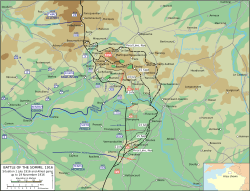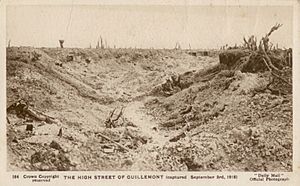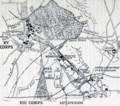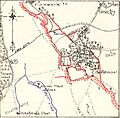Battle of Guillemont facts for kids
Quick facts for kids Battle of Guillemont |
|||||||
|---|---|---|---|---|---|---|---|
| Part of The Battle of the Somme of the First World War | |||||||
 Battle of the Somme 1 July – 18 November 1916 |
|||||||
|
|||||||
| Belligerents | |||||||
|
|
|||||||
| Commanders and leaders | |||||||
| Douglas Haig Ferdinand Foch Henry Rawlinson General Émile Fayolle |
Crown Prince Rupprecht of Bavaria Max von Gallwitz Fritz von Below |
||||||
| Strength | |||||||
| 6 divisions | |||||||
The Battle of Guillemont was a key part of the larger Battle of the Somme during the First World War. It took place from 3 to 6 September 1916. British and French forces attacked German troops near the small village of Guillemont in northern France.
This battle was important because Guillemont was a strong point in the German defenses. It was located on a high point, giving German soldiers a good view over the surrounding area. Capturing it would help the Allies move forward and gain better positions. The fighting for Guillemont had actually been going on for weeks, with many smaller attacks before this final push.
Why was the Battle of Guillemont important?
The Bigger Picture: The Somme Offensive
The Battle of Guillemont was part of the huge Battle of the Somme. This was one of the largest and bloodiest battles of the First World War. It involved millions of soldiers from different countries. The goal for the British and French was to break through German lines. They also wanted to relieve pressure on French troops fighting at Verdun.
German Defenses Were Strong
The German army had built very strong defenses around Guillemont. These included trenches, fortified villages, and farms. They had observation posts that allowed them to see Allied movements. This made it very hard for the British and French to advance. German soldiers were ordered to hold their ground at all costs.
Challenges for Both Sides
Both the Allied (British and French) and German armies faced many challenges. The battlefield was often muddy and difficult to move across. Heavy artillery fire destroyed roads and made supplying troops hard. Commanders also struggled to coordinate large attacks. This often led to smaller, costly attacks instead.
How did the Allies prepare for the attack?
Planning the Attack
The Allied commanders, like Sir Douglas Haig for the British and Ferdinand Foch for the French, met often. They tried to plan large, coordinated attacks. However, bad weather and tough German resistance often caused delays. They decided to focus on capturing Guillemont and nearby areas.
Getting Ready for Battle
British and French engineers worked hard to improve supply lines. They extended railways and built better roads. This was to bring more equipment and ammunition to the front. Artillery units also prepared by firing practice shots. This helped them aim their guns more accurately for the main attack.
New Tactics and Communication
The Allies tried new ways to attack. They used "creeping barrages," where artillery fire moved forward slowly. This was meant to protect advancing infantry. They also tried to improve communication. Soldiers used flares, flags, and even carrier pigeons to send messages. This was important because telephone lines were often cut by shelling.
What happened during the battle?
The French Attack
The French Sixth Army attacked first on 3 September. They pushed forward near the Somme River. They captured several villages and strong German positions. This helped to put pressure on the German forces. It also helped the British attack on Guillemont.
The British Attack on Guillemont
The British Fourth Army launched its main attack at noon on 3 September. Soldiers from the 5th and 20th Divisions led the charge. They advanced behind a creeping artillery barrage. The attack was very difficult due to heavy German machine-gun fire.
Fighting in the Village
British troops fought their way into Guillemont. They faced fierce resistance from German soldiers hidden in dugouts and shell-holes. The fighting was intense and often hand-to-hand. Communication was difficult, making it hard to send reinforcements.
Capturing Guillemont
Despite the tough fighting, the British managed to capture Guillemont. They took many prisoners and secured the village. This was a significant victory. It showed that the Allies could break through strong German defenses. German counter-attacks were launched but were pushed back.
Pushing Forward
After taking Guillemont, the British continued to advance. They moved towards nearby areas like Leuze Wood. The French also continued their push on their part of the front. This brought the Allied lines closer to the German third line of defense.
What was the outcome of the Battle of Guillemont?
A Costly Victory
The Battle of Guillemont was a British victory. However, it came at a high cost. Both sides suffered many casualties. Thousands of soldiers were killed or wounded. This battle, like many others on the Somme, showed the brutal nature of trench warfare.
Impact on the War
The capture of Guillemont was important for the Allies. It improved their position on the Somme front. It also helped set the stage for future attacks. These included the Battle of Ginchy and the Battle of Flers–Courcelette. The battle also showed the German army that they could not hold every inch of ground. This led to a change in their defensive strategy.
Heroism and Sacrifice
Many acts of bravery occurred during the battle. Several soldiers were awarded the Victoria Cross, the highest military honor. These include:
- CSM George Evans
- 2nd Lieutenant Gabriel Coury
- Captain Noel Godfrey Chavasse
- Private Thomas Hughes
- Lieutenant John Vincent Holland
- Sergeant David Jones
Their courage in the face of extreme danger is remembered.
Images for kids











